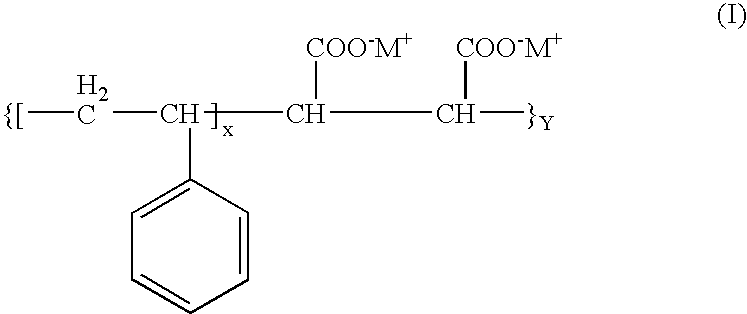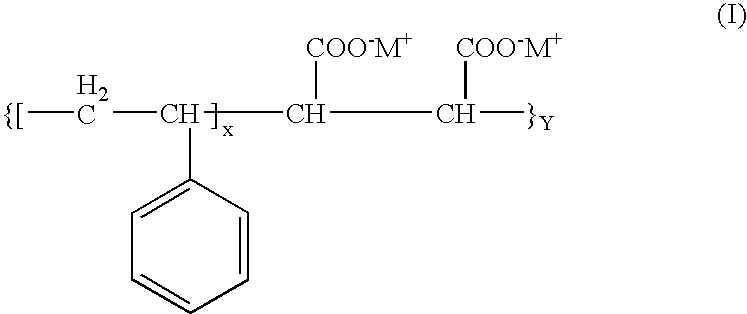Use of styrene-maleic anhydride copolymer to control black-to-color bleed
a technology of styrene-maleic anhydride and copolymer, which is applied in the field of can solve the problems of yellow, magenta, and black-to-color bleed, and develop black-to-color bleed control mechanisms such as those available, and achieve the effect of self-dispersion of black pigment inks and control of black-to-color bleed
- Summary
- Abstract
- Description
- Claims
- Application Information
AI Technical Summary
Benefits of technology
Problems solved by technology
Method used
Image
Examples
example 1
Formulation of the Black Inks
[0051] The following two black inks were prepared, listed below in Tables 1 and 2:
TABLE 1Black Ink #1.Componentweight %ammonium benzoate0.5Tris buffer0.51,5-pentanediol5.0glycerol propoxylate, MW 2664.02-methyl-1,3-propanediol5.02-pyrrolidinone3.0Surfynol 4650.1Proxel GXL0.2SMA-1000H polymer0.8Self-dispersed black pigment4.0waterto 100%
[0052]
TABLE 2Black Ink #2 (Control).Componentweight %ammonium benzoate0.5Tris buffer0.51,5-pentanediol5.0glycerol propoxylate, MW 2664.02-methyl-1,3-propanediol5.02-pyrrolidinone3.0Surfynol 4650.1Proxel GXL0.2Self-dispersed black pigment4.0waterto 100%
[0053] Both inks contained 4% of self-dispersed pigment prepared based on Monarch 700 polymer by using the method described in U.S. Pat. No. 5,571,311 of Belmont et al. Black ink #1 contained 0.8% of SMA-1000H polymer as based on the dry weight, or 2% as based on the 40% solution in water in which the polymer is supplied, while black ink # 2 was a control. Both inks were t...
example 2
[0056] The following black inks were prepared, listed below in Tables 4 and 5:
TABLE 4Black Ink #3.Componentweight %ammonium benzoate0.5Tris buffer0.351,5-pentanediol7.5Liponic ethylene glycol (LEG-1)4.02-methyl-1,3-propanediol7.52-pyrrolidinone4.5Surfynol 4650.15Proxel GXL0.15SMA-1000H polymer0.8Self-dispersed black pigment3.0waterto 100%
[0057]
TABLE 5Black Ink #4 (Control).Componentweight %ammonium benzoate0.5Tris buffer0.351,5-pentanediol7.5Liponic ethylene glycol (LEG-1)4.02-methyl-1,3-propanediol7.52-pyrrolidinone4.5Surfynol 4650.15Proxel GXL0.15Self-dispersed black pigment3.0waterto 100%
[0058] Both inks contained 3 wt % of self-dispersed pigment prepared based on Monarch 700 polymer by using the method described in U.S. Pat. No. 5,571,311 of Belmont et al. Black ink #3 contained 0.8 wt % of SMA-1000H polymer as based on the dry weight, or 2 wt % as based on the 40% solution in water in which the polymer is supplied, while black ink # 4 was a control.
[0059] The inks were print...
PUM
| Property | Measurement | Unit |
|---|---|---|
| Current | aaaaa | aaaaa |
| Current | aaaaa | aaaaa |
| Digital information | aaaaa | aaaaa |
Abstract
Description
Claims
Application Information
 Login to View More
Login to View More - R&D
- Intellectual Property
- Life Sciences
- Materials
- Tech Scout
- Unparalleled Data Quality
- Higher Quality Content
- 60% Fewer Hallucinations
Browse by: Latest US Patents, China's latest patents, Technical Efficacy Thesaurus, Application Domain, Technology Topic, Popular Technical Reports.
© 2025 PatSnap. All rights reserved.Legal|Privacy policy|Modern Slavery Act Transparency Statement|Sitemap|About US| Contact US: help@patsnap.com



